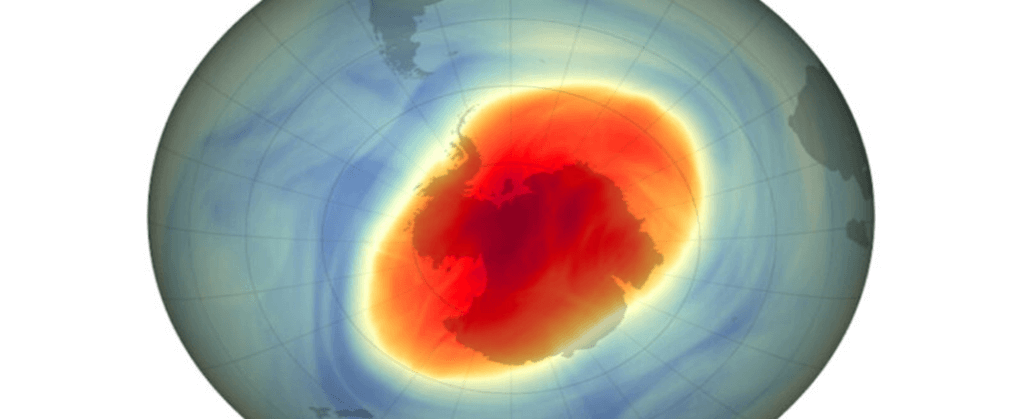Daily Current Affairs : 12-October-2023
Satellite measurements over Antarctica have recently unveiled a startling discovery: a colossal hole in the ozone layer, measuring 26 million square kilometers, nearly three times the size of Brazil. This ozone-depleted area, detected by the European Space Agency Copernicus Sentinel-5P satellite, has raised concerns worldwide. In this essay, we will delve into the key details of this issue, analyzing its causes, potential consequences, and the significance of ozone layer conservation efforts.

Understanding the Ozone Layer:
The ozone layer, a trace gas in the stratosphere, serves as a vital protective shield, absorbing harmful ultraviolet radiation. This shielding effect is crucial for human health, preventing conditions like skin cancer caused by excessive UV exposure. The size of the ozone hole over Antarctica fluctuates annually, opening in August and closing in November or December, due to specific atmospheric conditions.
Unveiling the Causes:
This year’s unprecedented ozone hole is attributed to volcanic eruptions at Hunga Tonga in Tonga during December 2022 and January 2023. Typically, volcanic gas remains below the stratosphere level, but this eruption introduced significant water vapor, bromine, and iodine into the stratosphere. These elements, through chemical reactions, impacted the ozone layer, enlarging the hole.
Human-Caused Ozone Holes:
The awareness of human-induced ozone depletion dates back to the 1970s. Alarming studies highlighted the adverse effects of substances released into the atmosphere, prompting global action. In 1987, the Montreal Protocol emerged as a significant step, phasing out the production of ozone-depleting substances. Following its implementation, the ozone holes gradually diminished, showcasing the protocol’s effectiveness.
Concerns and Consequences:
While this year’s ozone hole is linked to natural causes, it raises valid concerns about future trends. The ozone layer’s depletion poses a threat to human health, increasing the risk of skin cancers. Additionally, the altered UV radiation can disrupt ecosystems and harm various species, making conservation efforts imperative.
Conservation Efforts:
Preserving the ozone layer necessitates continuous global efforts. Stringent adherence to the Montreal Protocol remains crucial, ensuring that harmful substances are entirely phased out. Furthermore, promoting public awareness about UV protection and supporting research into ozone layer recovery techniques are vital steps in the conservation process.
Important Points:
- Giant Ozone Hole Discovery:
- Detected over Antarctica, measuring 26 million square kilometers, three times the size of Brazil.
- Discovered through satellite measurements by the European Space Agency Copernicus Sentinel-5P.
- Ozone Layer Significance:
- Ozone layer is a protective gas shield in the stratosphere, absorbing harmful ultraviolet radiation.
- Essential for human health, preventing conditions like skin cancer caused by excessive UV exposure.
- Annual Fluctuations:
- Ozone hole over Antarctica opens in August and closes in November or December due to specific atmospheric conditions.
- Linked to the Earth’s rotation causing special winds over Antarctica, creating a shield.
- Causes of Giant Ozone Hole:
- Linked to volcanic eruptions at Hunga Tonga in Tonga during December 2022 and January 2023.
- Volcanic eruption introduced water vapor, bromine, and iodine into the stratosphere, impacting the ozone layer through chemical reactions.
- Human-Caused Ozone Depletion:
- Awareness of human-induced ozone depletion since the 1970s.
- Montreal Protocol, established in 1987, phased out production of ozone-depleting substances, leading to smaller ozone holes in subsequent years.
- Concerns and Consequences:
- Ozone layer depletion poses a threat to human health, increasing the risk of skin cancers.
- Altered UV radiation can disrupt ecosystems and harm various species.
- Conservation Efforts:
- Stringent adherence to the Montreal Protocol is crucial, ensuring complete phase-out of harmful substances.
- Public awareness campaigns about UV protection and support for research into ozone layer recovery techniques are essential for conservation.
Why In News
Satellite measurements over Antarctica have detected a giant hole in the ozone layer, a concerning phenomenon that highlights the ongoing environmental challenges our planet faces. Scientists worldwide are closely monitoring this hole, emphasizing the urgent need for global cooperation to mitigate its expansion and protect our atmosphere for future generations.
MCQs about Ozone Layer Crisis
-
What is the primary function of the ozone layer in the Earth’s atmosphere?
A. Absorbing harmful ultraviolet radiation
B. Generating heat for the stratosphere
C. Regulating air pressure
D. Facilitating cloud formation
-
What caused the unusually large ozone hole discovered over Antarctica this year?
A. Human activities
B. Volcanic eruptions at Hunga Tonga
C. Deforestation
D. Natural climate change
-
What international agreement was established to protect the ozone layer?
A. Kyoto Protocol
B. Paris Agreement
C. Geneva Convention
D. Montreal Protocol
-
Why is the conservation of the ozone layer essential for ecosystems?
A. It regulates air quality
B. It prevents excessive rainfall
C. Altered UV radiation can disrupt ecosystems and harm various species
D. It promotes the growth of plants
Boost up your confidence by appearing our Weekly Current Affairs Multiple Choice Questions
![]()


